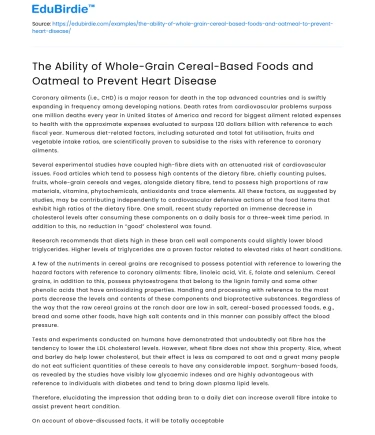Coronary ailments (i.e., CHD) is a major reason for death in the top advanced countries and is swiftly expanding in frequency among developing nations. Death rates from cardiovascular problems surpass one million deaths every year in United States of America and record for biggest ailment related expenses to health with the approximate expenses evaluated to surpass 120 dollars billion with reference to each fiscal year. Numerous diet-related factors, including saturated and total fat utilisation, fruits and vegetable intake ratios, are scientifically proven to subsidise to the risks with reference to coronary ailments.
Several experimental studies have coupled high-fibre diets with an attenuated risk of cardiovascular issues. Food articles which tend to possess high contents of the dietary fibre, chiefly counting pulses, fruits, whole-grain cereals and veges, alongside dietary fibre, tend to possess high proportions of raw materials, vitamins, phytochemicals, antioxidants and trace elements. All these factors, as suggested by studies, may be contributing independently to cardiovascular defensive actions of the food items that exhibit high ratios of the dietary fibre. One small, recent study reported an immense decrease in cholesterol levels after consuming these components on a daily basis for a three-week time period. In addition to this, no reduction in “good” cholesterol was found.
Save your time!
We can take care of your essay
- Proper editing and formatting
- Free revision, title page, and bibliography
- Flexible prices and money-back guarantee
Research recommends that diets high in these bran cell wall components could slightly lower blood triglycerides. Higher levels of triglycerides are a proven factor related to elevated risks of heart conditions.
A few of the nutriments in cereal grains are recognised to possess potential with reference to lowering the hazard factors with reference to coronary ailments: fibre, linoleic acid, Vit. E, folate and selenium. Cereal grains, in addition to this, possess phytoestrogens that belong to the lignin family and some other phenolic acids that have antioxidizing properties. Handling and processing with reference to the most parts decrease the levels and contents of these components and bioprotective substances. Regardless of the way that the raw cereal grains at the ranch door are low in salt, cereal-based processed foods, e.g., bread and some other foods, have high salt contents and in this manner can possibly affect the blood pressure.
Tests and experiments conducted on humans have demonstrated that undoubtedly oat fibre has the tendency to lower the LDL cholesterol levels. However, wheat fibre does not show this property. Rice, wheat and barley do help lower cholesterol, but their effect is less as compared to oat and a great many people do not eat sufficient quantities of these cereals to have any considerable impact. Sorghum-based foods, as revealed by the studies have visibly low glycaemic indexes and are highly advantageous with reference to individuals with diabetes and tend to bring down plasma lipid levels.
Therefore, elucidating the impression that adding bran to a daily diet can increase overall fibre intake to assist prevent heart condition.
On account of above-discussed facts, it will be totally acceptable to brand health claims on labels or these cereals’-based foods (as at the present time permitted by the US Food and Drug Authority) that whole-grain cereal-based foods and oatmeal or bran might be capable of reducing the risk of CHD.






 Stuck on your essay?
Stuck on your essay?

